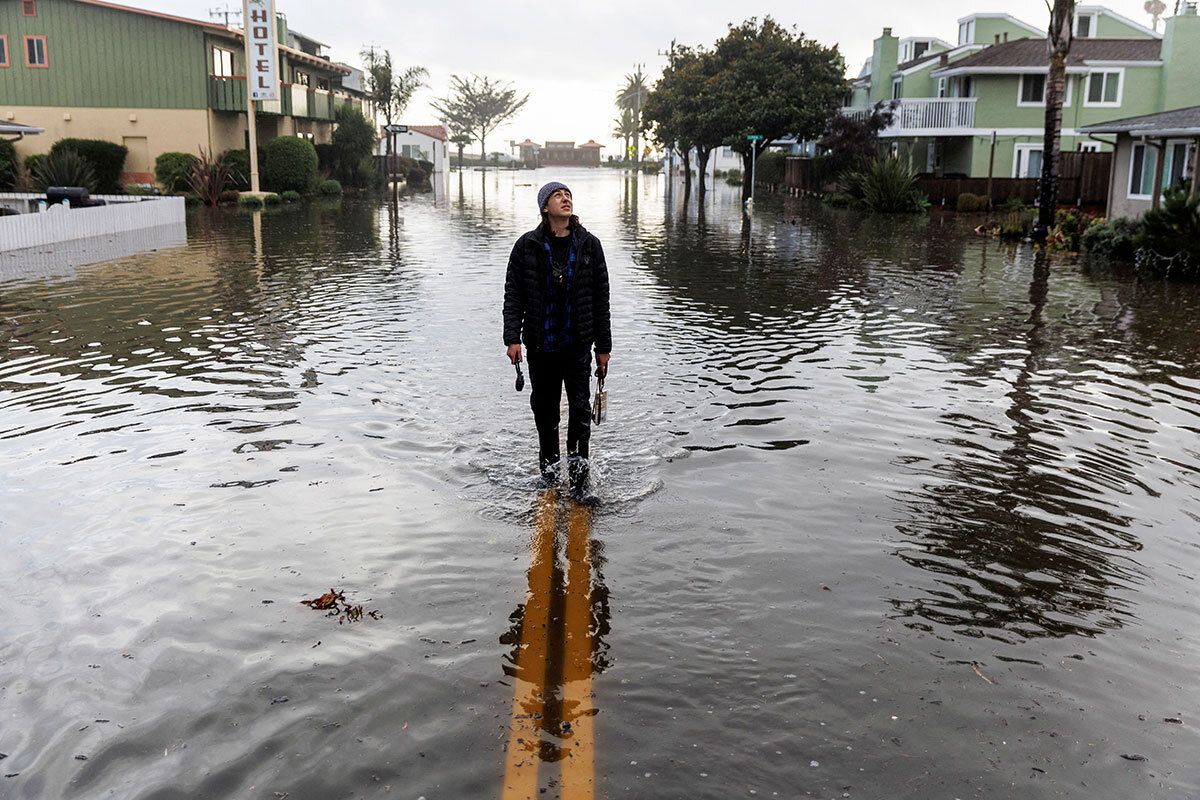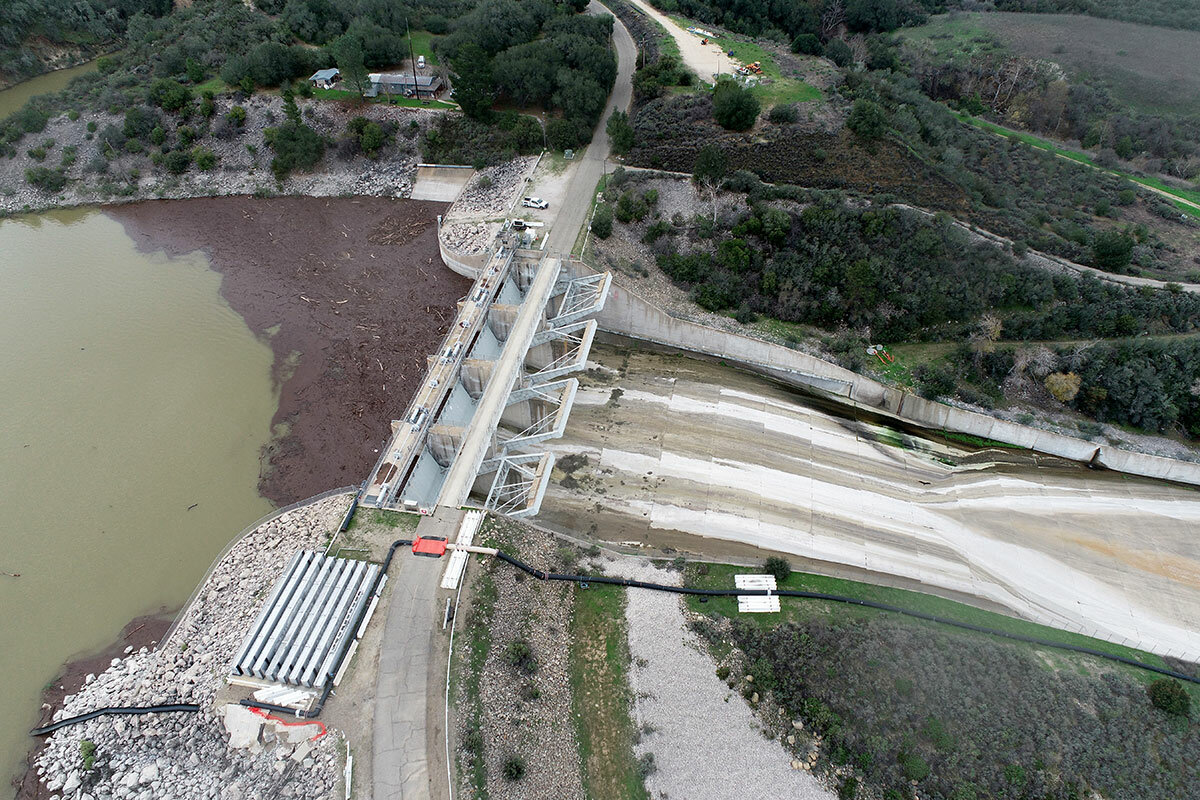California storms: When a year’s worth of rain in two weeks isn’t enough
Loading...
| Bakersfield, Calif.
As President Joe Biden heads to a sodden California Thursday, the state is trying to clean up after a series of storms dumped over a year’s worth of rainfall in under a month, causing at least 20 deaths and billions of dollars in damages.��
One set of calculations estimates of water fell across the state during the first two weeks of storms, which started Dec. 27. The series of atmospheric rivers –��at least nine –��that brought the deluge took forecasters by surprise, causing flood warnings for 90% of Californians and forcing tens of thousands of residents to evacuate their homes.��
The California��Geological Survey has mapped almost 600 mudslides since the storms began – a result of heavy rain on top of loose, dry landscapes and burn scars throughout the fire-prone state. Despite the destruction, rain is much-needed relief after three years��of a drought so profound it is transforming the state. The relief is tempered, though, by how much more water California still needs.��
Why We Wrote This
After weeks of massive rainstorms, California and the American West are grappling with how to manage flood risks, rebound from drought, and make new plans for the Colorado River Basin.
Is California still in a drought?��
Yes,��and it's been unusually extreme, including two straight years with zero water deliveries to most Central Valley agricultural contractors and the first-ever shortage declaration in the Lower Colorado River Basin.
But now��the drought has become . Before the storms, 81% of the state was in severe drought, which adds stress on wildlife and trees, extends fire season, and results in insufficient pasture for livestock; 36% of the state was in extreme drought, with insufficient water for agriculture, wildlife, or urban use, and reservoirs so low their hydropower was limited; and 7% of the state was in exceptional drought – the severest category –��which means native plants and animals start to die off, orchards need to be removed, and the area becomes prone to extensive fires.
As of Tuesday, essentially none of California was in a state of exceptional or extreme drought. Over 95% of it remained in moderate drought, and 46% in severe drought (categories overlap).��
The massive deluge does not solve California’s long-term water needs, which are impacted by the changing climate conditions leading to more severe weather events, including drought.��
Where is all this water going? Can it be stored and used later?
Some of the rainwater is flooding rivers, flowing out to sea, and washing into storm drains. “So even though we’re getting a lot of rain again, a lot of that water is unusable over the course of the year and basically contributes very little to our long-term water issues,” says Paul Ullrich, professor of regional and global climate modeling at the University of California, Davis.��
But much of it is also making its way to the 1,500 reservoirs that, along with thousands of miles of canals, aqueducts, and rivers, make up the state’s water grid. While the vast majority of reservoirs are managed by local agencies and private companies, some 240 combine for 60% of the state’s water storage capacity – and those are managed by state and federal agencies.
Eight of the state’s 17 major reservoirs have above-average water levels. California’s largest reservoir – Lake Shasta – is filled to just over half of capacity, and 83% of its historical average. Lake Oroville, the state’s second-largest reservoir, is slightly over the historical average, at 56% capacity. Trinity, which neighbors Lake Shasta about 200 miles north of Sacramento, is just 30% full.����
Part of reservoirs’ job is to be ready for future deluges – so as they fill up, water is released from the dams to make space for more water. The right balance maximizes the amount of water the reservoirs retain while predicting how much room they’ll need for incoming storms or runoff. As weather predictions become more and more accurate, ��(FIRO) are helping guide the timing and amount of these releases. Local, state, and federal agencies are working together on FIRO initiatives at a handful of California reservoirs. On Tuesday, the U.S. Army Corps of Engineers, along with Sonoma Water, managed the first high-flow water release from the Coyote Valley Dam since the most recent drought started in 2020. The initiative is credited with taking the dam’s Lake Mendocino from completely dry three years ago to its highest water levels in at least a decade.
Smaller systems are probably in better shape than they were a month ago, as long as they were able to manage the aggressive water flows, according to Mike Anderson, state climatologist with the California Department of Water Resources. And a “lot of [larger systems]��are ... recovering their conservation storage and maybe pivoting into a flood management role. So you have recovery there,” he said at a news briefing Monday.
Groundwater also plays a major part in the water grid, accounting for anywhere from 40% to 60% of the state’s water supply, depending on rainfall. The drier the year, the more water is needed from aquifers. Nearly 2 million wells provide water for rural households, agriculture, and the larger water grid. Those wells are at record pace – posing serious risks to the communities that depend on them for drinking water, and to California’s $20 billion agriculture industry. Given California’s perennial��drought, overpumping of aquifers has become a central concern, especially in the agriculture-driven Central Valley, which typically gets at least two-thirds of its water from underground, .
The rain has helped recharge the aquifers, as it has reservoirs – but again, it’s not enough. As of Wednesday, 10% of the state’s monitored wells registered above-normal levels. Nearly two-thirds were below normal. “There are still major parts of the state which have exhausted effectively their groundwater supplies,” says Dr. Ullrich. This “makes it impossible ... to fall back on anything in case there’s any sort of water shortage.”
What about snow? Will that help?����
Another indicator of long-term water supply is the snowpack, which builds up in winter and then runs into rivers, lakes, and reservoirs when it thaws throughout spring and summer.��
California’s mountain regions have two to three times the average snowpack for this time of year – ahead of the record 1982-83 season (record keeping began in 1950). “Epic levels,” says Dr. Anderson, who points out that the snow’s impact on the water system remains to be seen. Peak snowmelt in the northern Sierra generally comes in April, and in the southern Sierra it can peak as late as June, he says. With much of winter still ahead, and the potential for more snowfall –��but no guarantee – it’s too soon to know if the snowpack will cause more flooding when it melts.
Have the storms affected neighboring states –��or the Colorado River Basin?��
The atmospheric rivers stretched into Oregon and Washington state, and then moved east to the Rocky Mountains, where snow feeds the Colorado River. The Colorado River Basin provides water to 40 million people in seven states – Colorado, New Mexico, Utah, Wyoming, Nevada, Arizona, and California –��and it’s running dangerously low. So low, those states have until Jan. 31 to come up with plans to reduce their water use, or the U.S. Bureau of Reclamation will step in and dictate the cuts. That deadline, and the need for states to drastically reduce their water use, have not been affected by the winter storms.��
The Upper Basin has received more than 150% of median snowpack in some places. But “one wet season is not enough to fully resolve the river’s water issues,” said Erinann Saffell, state climatologist with the Arizona Department of Water Resources, via email.��
Arizona gets about 35% of its water supply from the Colorado River Basin, with 60% coming from groundwater and Arizona rivers. The state’s short-term drought conditions have improved with the wet winter, but “Arizona remains in a long-term drought,” says Dr. Saffell.
While the swollen rivers recede in California, residents have a reprieve from water restrictions – and officials say not to get used to it. “We don’t know when the next drought is going to happen,” says Ryan Endean, assistant deputy director of communications for the California Department of Water Resources. “So we’re always encouraging Californians to be smart with their water usage. ... That’s just good practice going forward in California.”
Staff writer Francine Kiefer contributed to this report from Pasadena, California.







